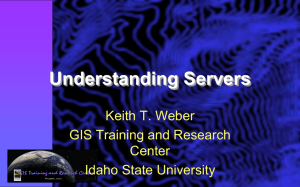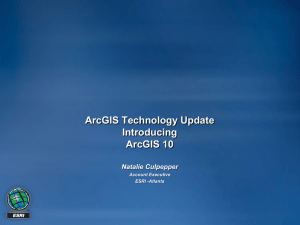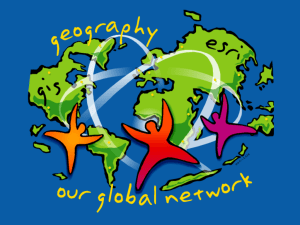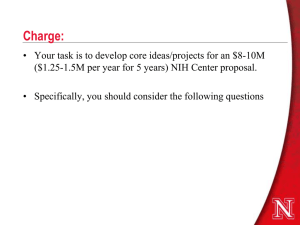Community-based Climate Resiliency: Engaging Hearts and Minds
advertisement
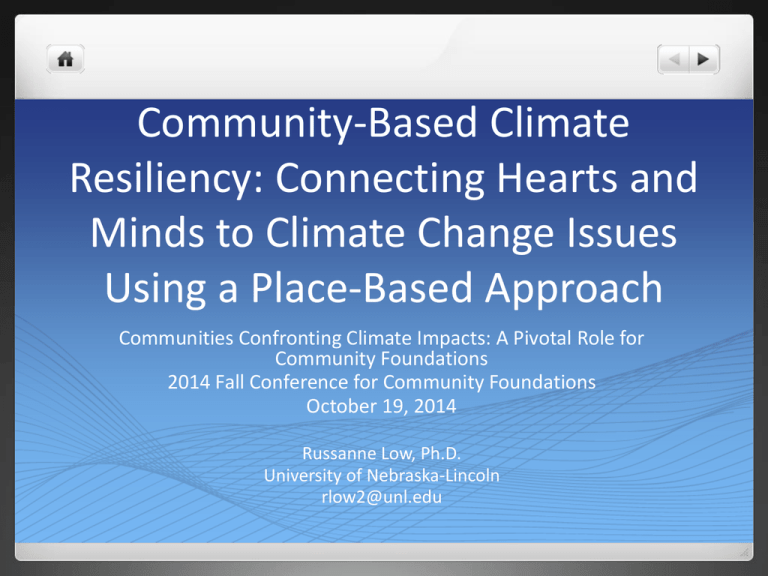
Community-Based Climate Resiliency: Connecting Hearts and Minds to Climate Change Issues Using a Place-Based Approach Communities Confronting Climate Impacts: A Pivotal Role for Community Foundations 2014 Fall Conference for Community Foundations October 19, 2014 Russanne Low, Ph.D. University of Nebraska-Lincoln rlow2@unl.edu Outline of Slide Stack This presentation highlights one project and one tool designed for community climate change explorations, developed in conjunction with NASA/NOAA/NSF’s Triagency collaborative climate change education program. Goals of the projects Rationale for our use of a community-based, local approach to climate change education, communication and outreach Example 1: collaborative, community-based project: GIS, Food, Water and Sustainability course, taught collaboratively and on-line for learners in NYC and rural Nebraska Example 2: Community Climate Chronicle research tool, designed to prepare communities for discussion about community climate vulnerability and resilience Evaluation Final Remarks Broad goals of our federally funded work in climate change education and outreach Goal 1: broaden access to cutting edge science and high quality educational resources Goal 2: build climate literacy amongst our program participants Goal 3: connect learners to cutting –edge technological tools, including GIS (Geographic Information Systems) Goal 4: Evaluate the role of authentic climate change research at the community level in building climate change literacy and its role in promoting personal behavioral changes to promote community resilience and sustainability Humanitarian goal: catalyze change in fossil fuel use and consumption behavior Computer models evidence that the future of the Earth’s climate hinges on our now and future behaviors. If we lower our emissions of heat trapping gases, we can mitigate against drastic changes in temperature by the turn of the century. Our three-pronged approach: Teach the science Motivate individuals and communities by making the science relevant and local Shift authority about local climate change to community members through their participation in local citizen science research Why community focus? Image: http://www2.epa.gov/region8/climate-change-impacts-epa-region-8 We need community engagement… we know that science alone can’t drive this bus! The brain lights up differently and we learn more efficiently when emotions are turned on! Climate change, reported in the media, is described as too far away in time (>50 years) and too abstract (global impacts, far away) to connect with the hearts and minds of the majority of people (Hulme 2009). The problem is too remote- both spatially and temporally to motivate the majority of individuals to significantly change their behavior Going from knowledge to action requires engaging both the analytical-rational and the intuitive-experiential information processing systems of the brain. The rational processing system is logical and abstract; the experiential is affective (moods, feelings, attitudes) and tangible A place-based focus on climate change translates abstract concepts into concrete experience Making climate change relevant to individuals and communities: taking cues from research in the social sciences (psychology, communication, anthropology, sociology…) Shift nexus of authority from scientists to the community members themselves Tap into social identities and affiliations, by highlighting local community as focus of exploration Get audience’s attention, by focusing inquiry on those aspects of of life in the community they care about: whether economic, social, sport, or hobby Encourage group participation, facilitating emergence of necessary changes in personal behavior and community priorities to ensure a sustainable future Our messaging: Climate change is real and happening now -- Prove it to yourself: find evidence in your backyard You can do something to make a difference --Take climate change from concept to action in a service learning project Remove barriers to action by contextualizing climate change as an issue that can be explored locally By engaging community members in doing local research, we shift the nexus of authority from scientists to the community members themselves The research they conduct is original- at a scale of spatial granularity that is rarely seen in institutionally funded climate science In doing so, participants translate abstract scientific concepts into meaningful concrete experience, engage the intuitive-experiential information processing system of the brain UNL Projects funded by the Triagency climate education programs • Courses developed for teachers, offered through UNL’s Masters of Applied Science, Science Educator Concentration • Supports teachers in creation of lessons that promote authentic student research experiences and empower students to be agents of change • Note: The UNL series of graduate-level online Lab Earth courses for educators, of which these are now a part, was originally funded by the Toyota Foundation (developed collaboratively with Brooklyn College) Collaboration and sharing of resources by scientists and climate change educators make this approach possible Example 1: GIS, Food, Water and Sustainability Online course collaboratively developed and co-taught at University of Nebraska-Lincoln and Brooklyn College, NYC. Brings together learners from urban and rural environments to explore climate change in these two different areas with respect to access to food and water, through spatial explorations of data using ArcGIS Online. Employs open-source learning objects found in digital libraries created by member of the climate change education community Example 1: GIS, Food, Water and Sustainability Online course co-taught at University of Nebraska-Lincoln and Brooklyn College, NYC. Brings together learners from urban and rural environments to explore what climate change means in these two different areas with respect to access to food and water, through spatial explorations of data using ArcGIS Online. Note: ArcGIS Online is available free to all K-12 schools and is a low-cost option for teaching and using GIS in the cloud. Evolving quickly, it has powerful spatial analysis capabilities and web apps that allow users to upload map products to social media. Because it resides in the cloud, technical issues with teaching GIS online are virtually eliminated. http://www.esri.com/software/arcgis/arcgisonline Example 1: GIS, Food, Water and Sustainability Employs open-source learning resources created by member of the climate change and Earth system science education communities found in these federally-funded digital repositories: http://cleanet.org/index.html http://nasawavelength.org/http://nasawavelength.org/ http://www.camelclimatechange.org/ Example 1: GIS, Food, Water and Sustainability Module 1: Geospatial Technologies and the Earth System. This module provides an introduction to geospatial technologies and the pervasive roles these play in our every day lives. Learners explore various applications and become familiar with web mapping through use of ArcGIS online. Emphasis in this module is placed on improving spatial and technological literacies related to remote sensing and GIS, and applying them to the learner’s local community and environmental context Module 2: Landscape Analysis: Watershed and On-line GIS. Module 2 focuses on explorations on a landscape scale of analysis, using the concept of a watershed as a frame of reference. Students compare and contrast the Salt Watershed in Nebraska with the NYC water supply system, and use an interactive watershed tool to solve problems of local development and water runoff in a quantitative context Module 3: Analysis of Large Datasets using ArcGIS online. Students download large data sets, build deeper understanding of spatial analysis, and explore AR4 climate change scenarios by building an interactive time-aware web map application. Module 4: Individual and Group Projects. In past years we have had projects focusing on Superstorm Sandy (NYC), drought (NE), flood (CO) and sustainability (in conjunction with Brooklyn College field school in Barbuda, Lesser Antilles. Example 2: Community Climate Chronicles: A Community Driven Local Climate Change Research Tool 10 Steps to Community Resilience Planning Readiness Background knowledge in climate change science provided by 10 education modules funded by NASA in PBS Learning Media. Each module engages the learner in examination of climate change data and coming to their own conclusions about what climate change means to them. The module, going Local with Global Warming, served as the basis for development of the Community Climate Chronicle research tool created at UNL. Climate change educational resources PBS Learning Media NASA, reused in Educator-Climatologist Learning Community Project, UNL, funded by NASA’s Innovations in Climate Change Education Program. Source: PBS Learning Media, http://www.pbs.org/teachers/stem/professionaldevelopment/ Example 2 Community Climate Chronicle: A Community Driven Local Climate Change Research Tool 10 Steps to Community Resilience Planning Readiness Step 1. Engage participants by showing videos that capture non-specialist narratives of observed changes in communities in the U.S. and around the world Climate change educational resources created by WGBH funded by NSF and NASA, reused in Educator-Climatologist Learning Community Project, UNL, funded by NASA’s Innovations in Climate Change Education Program. Source: PBS Learning Media, http://rmpbs.pbslearningmedia.org/search/?q=wisconsin&selected_facets= Step 2. Participants create their own Community Climate Chronicle • Coming up with great research questions: not easy! • The Community Climate Chronicle is a structured activity to to assist teachers/community leaders in the development of place-based research questions for group exploration. • Currently piloted only in teacher educator settings for use in classroom, but designed for implementation by community groups Sometimes, there are great insights…. • Move climate change from a global, abstract idea to a local, concrete consideration • Provide structured exploration of community livelihood and values • Connect people with tools to discover for themselves what future climate might meet for their community • Provide opportunities for personal engagement in building awareness and taking action on a local scale 3. Consult Archival Data Sources • • • • Farmer journals Hunting logs Local newspapers Historical society archives • Engage in original research: these are analog resources that are rarely examined by climate scientists, because finding them is so labor intensive– • Residents to become the expert on climate change in their own community-shifting the nexus of authority to known and respected members of the community 4. Participate in Citizen Science (Phenology) Konza Prairie Wildflowers Konza Prairie, KS Observation: earlier flowering in Konza Prairie Question: Does the change in flowering time indicate that average temperatures have been increasing in recent decades? Hypothesis: Earlier spring warmth is causing earlier flowering Refine Hypothesis as needed: Earlier? Higher extremes? Lower extremes? Averages? 5. Put local observations in a global context Plot climate model projections in ArcGIS online Run climate models Plot historic climate data Create graphs and scientific visualizations 6. Look at local historical climate data • Noisy data is statistically examined and demonstrates a trend toward increased drought conditions since the late 1800’s • Dustbowl era clearly shown in 19301940’s • Suggests hypothesis that drought conditions are increasing with time • Climate at a Glance- a great tool that allows for exploration of a variety of climatic parameters over time: http://www.ncdc.noaa.gov/cag/ • 7. You be the expert: Compare data you have collected, observed and analyzed to the regional synopsis from the 3rd National Climate Assessment Source: http://www.globalchange.gov/explore/great-plains 8. Disseminate Public service announcement (undergraduates) Service Learning project (K-12 students) Create Community Action Plans (community members) explicitly connects service needs and learning goals builds bridges between cognitive and affective domains Improve learning and retention Move learners from information to action Service Learning activities were developed by teachers to allow students to collect/use/interpret data and solve a problem in their community related to climate change Planting a butterfly garden…Public Service announcements…Town Hall presentations School recycling/energy conservation…Personal/family/school carbon footprints Planting trees…Citizen science environmental monitoring (2012-2013 projects) 9. Evaluate Example of classroom assessments by Teachers: pre and post activity “Overall, the CMA4 unit plan coupled with the service-learning project has had an impact on both our students and teachers. Data shows dramatic increases in: • Concern about climate change • Understanding of the role of humans in climate change • Increase in sustainable behaviors among participants Because more students now understand climate change is serious, ideally, too, we will have enough of a following to influence the tight political hold that has gripped our current school board (preventing) teachers to teach about climate change (although we are allowed to if we “teach the other side”…whatever that means).” Step 10: Community Action Planning Our project described here is limited to impacting community through actions of teachers and students. Step 10 needs leadership and expertise from within communities and funding from sources that are not targeting K-12 and university education (A need to be filled!) Goals and outcomes discussed here fit into this logic model, used for planning of project and evaluation of outcomes, Triagency Climate Change Education Projects Source: Dr. Ann Martin, NASA LARC and the TriAgency Evaluation Working Group Based on sample of 100+ teachers, 3000 students, qualitative and quantitative data show local research experience and service learning help individuals understand the abstraction of climate change in a concrete and personally experienced manner and are more likely to influence behavior and actions than traditional classwork alone Land is Life is a 501c3 organization dedicated to elevating indigenous voices and upholding the right to self determination. The Advocacy for Indigenous Peoples’ Rights and Climate Change (publication 2014) includes repurposed activities and resources developed in conjunction with some of the UNL projects mentioned in this slide stack. http://www.landislife.org A decade + of education and outreach research: What we have done Federal agencies have supported millions of dollars worth of climate change education and outreach tools that can be leveraged by communities Instead of isolated efforts that have impact only at the institutions and communities where they take place, NASA, NOAA and NSF have created a triagency structure that encourages and permits project leaders to share products and outcomes and learn from each other’s successes and challenges This has led to the adoption of uniformly high standards with respect to educational products that can be reused and repurposed, as well refining and standardizing evaluation instruments so that we can better understand the challenges of building climate change awareness and climate change understanding A decade + of education and outreach research: What we have learned The challenge is greater than communicating the science and making scientists accessible Climate change is a global grand challenge that requires input from professionals in many fields, including economics, sociology, communications, psychology, anthropology, and spirituality Our research indicates that climate change science is a baseline of understanding that people need, but it is insufficient to stimulate action and change in behavior on a large scale. Our approach is to provide tangible examples of how a changing climate can impact people in their community and tools that can empower them to make their communities more resilient in the face of changes that are coming– and the changes are not only climate, but climate-related changes in the economy- agriculture and industry, changes in culture, changes in behavior… Take home messages Federal agencies have supported millions of dollars worth of climate change education and outreach tools- created by scientists and climate change educators, and rigorously tested and assessed by professional evaluators. These products are available and can be leveraged by communities Approaches to community resilience action and awareness have been piloted and assessed in educational contexts and can be employed in other contexts and by community groups “Far from being simply a change in physical climates- a change in the sequences of weather experienced in given places- climate change has become an idea that now travels beyond its origins in the natural sciences,” and we might ask, “How does the idea of climate change alter the way we arrive at and achieve our personal aspirations and our collective social goals?” (Mike Hulme 2009, Why We Disagree about Climate Change: Understanding Controversy, Inaction and Opportunity) Contact Information about Projects and Tools: Russanne Low, University of Nebraska-Lincoln rlow2@unl.edu Rebecca Boger, Brooklyn College beckyboger@gmail.com David Gosselin, University of Nebraska-Lincoln dgosselin2@unl.edu “If you want to go quickly, go alone. If you want to go far, go together.” — African Proverb
